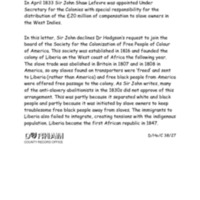
Exhibition to mark the bicentenary of the 1807 Act
Durham Record Office held an exhibition of its original documents relating to slavery, the slave trade and abolition. These include reports, maps, and a number of letters, from, for example, Sir John Shaw Lefevre (Under Secretary for the Colonies in 1833), the abolitionist James Stephen and the prominent Quaker activist Josiah Forster. The exhibition was displayed in the Record Office and toured several venues in the region. It was also used for inspiration by members of Jackass Youth Theatre, who produced the play Sharp Practice after visiting the Record Office and consulting some of the original documents on display.
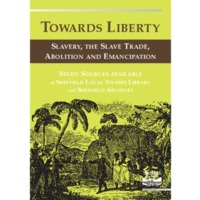
Towards Liberty: Slavery, the Slave Trade, Abolition and Emancipation
This booklet was produced to mark the bicentenary in 2007 and to highlight the material available in Sheffield Local Studies Library and Sheffield Archives for the study of slavery, the slave trade, abolition movements and emancipation. It looks, in particular, at the role of the city of Sheffield and the surrounding areas, and its local residents. Sheffield benefited from the slave system in that goods manufactured in the city's factories were used on the plantations in the West Indies and America. Sugar and coffee produced on the plantations was consumed by residents. There were active anti-slavery groups in Sheffield, including the Ladies Anti-Slavery Society, and petitioning and boycotts were common. Hannah Kilham, a Sheffield Quaker, published a memoir of her experiences in West Africa as a teacher in the 1820s and 1830s.
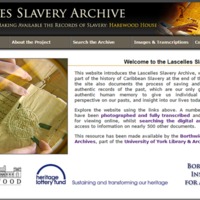
Lascelles Slavery Archive
The Lascelles Slavery Archive was a collaborative project between the Borthwick Institute for Archives and Harewood House Trust to conserve, preserve and make available records relating to slavery from the archives of the Lascelles family of Harewood House, Yorkshire. The project deals with a new discovery of papers relating to the family's fortune based on its estates in the West Indies. Key documents providing evidence for the acquisition of the family's wealth, once thought lost, were found in poor condition during an inventory of Harewood House. The Lascelles Slavery Archive is available through the Borthwick's searchrooms as an online resource, and represents an important section of the larger archive of the Lascelles family held by West Yorkshire Archive Service.
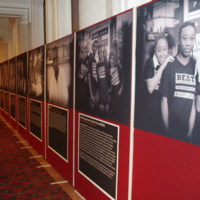
Freedom Roads
The Freedom Roads exhibition at Guildhall Art Gallery was one of several initiatives led by London Metropolitan Archives to mark the bicentenary. The exhibition featured contemporary photographic portraits of people of African origin whose work has contributed to the continuing struggle for human rights in different fields. Colin Prescod, Shirley Thompson, Eric and Jessica Huntley and Rudolph Walker were amongst the individuals featured. Others like the young people from BEAT (Black Experience Archive Trust) were engaged in a project to find out about significant people in their local community. Each person was photographed with an image of an object or place which has a special significance to them. The other part of the exhibition focused on relevant archival materials held by London Metropolitan Archives, including the South African Bill of Rights and a copy of the Constitution signed by Nelson Mandela, Cyril Ramaphosa, F. W. De Klerk and Roelf Meyer. Other material relating to slavery and abolition included a letter from John Julius, a plantation owner on the island of St. Kitts.
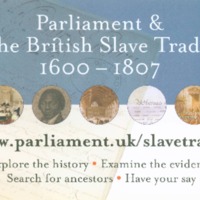
The British Slave Trade: Abolition, Parliament and People
This exhibition in Westminster Hall told the story of the pressures and events, at home and abroad, which influenced Parliament's abolition of the British slave trade in 1807. The Act itself was displayed alongside petitions sent to Parliament by the public. Also on display was Thomas Clarkson's African Box, used on his abolition tours.
As part of the wider project, the Parliamentary Education Service appointed poet and writer Rommi Smith as Parliamentary Writer in Residence to the exhibition. In a series of workshops, Rommi worked with secondary school pupils to explore the historical, social and emotional issues around the transatlantic slave trade in poetry and prose. This included letters and statements that they would have sent to the prime minister of the time, to Olaudah Equiano and other key figures. To mark the UNESCO International Day for the Remembrance of the Slave Trade and its Abolition on 23 August 2007, the Parliamentary Education Unit asked people to submit squares for a commemorative quilt. Some of these designs are available to view on the Parliamentary Archives website, which also uses original source material to tell the story of Parliament's complex relationship with the British slave trade.
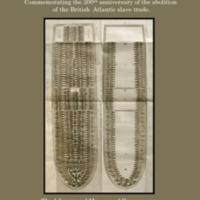
Squaring the Triangle: Freemasonry and Anti-Slavery
The exhibition at the Library and Museum of Freemasonry to mark the bicentenary arose from a project to catalogue their historical collections relating to Masonic history in the West Indies and America between 1760 and 1900. This period covers the establishment of African Lodge, the first Masonic lodge for African-Americans. Its first Master was Prince Hall, a freed slave and respected Boston resident who had fought for the British. From 1847 his name has been synonymous with Prince Hall Masonry, the first major Black Masonic organisation in the world. The library holds eleven letters written by or for Prince Hall. The exhibition and cataloguing of this correspondence enabled the library to start compiling details of early Black and Asian Freemasons in its collections. The exhibition also looked at members in the 18th and 19th century who were both slave owners and abolitionists, and the establishment of lodges in the Caribbean.
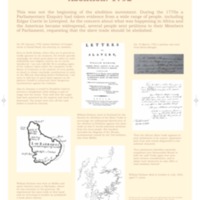
Dumfries and Galloway and the Transatlantic Slave Trade
An exhibition exploring the connections between the Scottish region of Dumfries and Galloway and the transatlantic slave trade toured Dumfries Museum, the Stewartry Museum in Kirkcudbright and Stranraer Museum. At each venue, the exhibition was accompanied by displays of material and a lecture. The catalogue of new research to supplement the exhibition by Frances Wilkins set out to correct misunderstandings about the role of people from the region in the transatlantic slave trade, to prove a history of connections independent of Glasgow or anywhere else. Evidence suggests that men from smaller towns such as Dumfries and Kirkcudbright were involved in the transatlantic slave trade as merchants, slave traders or plantation owners. For example, in the late 18th century, plantation supplies were sent from Kirkcudbright to the island of Grenada; the vessels returned with rum, sugar, and cotton wool.

'Irreconcilable with the principles of justice and humanity': the trade in slaves and its abolition
An exhibition held in the Special Collections Gallery at the Hartley Library, University of Southampton. The exhibition took a broad view of the subject of transatlantic slavery across the 18th and 19th centuries, featuring accounts of the horrors of the transatlantic slave trade, the case for abolition, and contemporary tracts and pamphlets putting forward the arguments for total abolition. Alongside these were discussions of the place of slavery in the economy of the West Indies, and the detail of measures taken by governments, such as that of the first Duke of Wellington in 1828-30, and the work of the third Viscount Palmerston, as Foreign Secretary and Prime Minister. The exhibition also looked at the efforts of the Royal Navy to enforce legislation and treaties against slave trading.
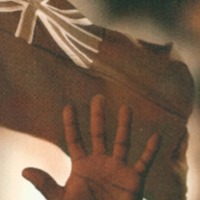
Chasing Freedom: The Royal Navy and the Suppression of the Transatlantic Slave Trade
An exhibition at the Royal Naval Museum at Portsmouth Historic Dockyard explored the role of the Royal Navy squadron established after 1807 to patrol the West African coast and suppress the transatlantic slave trade. Using illustrations, contemporary accounts and original diaries of Royal Navy personnel, the exhibition examined key aspects of the campaign against Atlantic slave traders. It also looked at the Royal Navy's efforts against human trafficking and in the pursuance of humanitarian rights today. There was an accompanying programme of schools workshops and community events. Two specially produced films discussed the legacy of the squadron's work and recreated the abolition debates of the time.
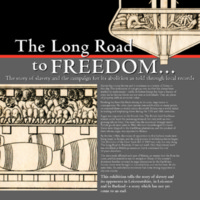
The Long Road to Freedom
As made clear by The Long Road to Freedom exhibition in 2007, the Record Office for Leicestershire, Leicester & Rutland contains a significant collection of documents which reveal local connections with the slave trade, and with those who campaigned for abolition. Several prominent local families owned slaves on plantations in the Caribbean and on the north coast of South America. Leading Leicester abolitionists, Elizabeth Heyrick and Susanna Watts, orchestrated a vigorous anti-slavery campaign in Leicester, including a boycott on sugar. Local landowner, Thomas Babington of Rothley Temple, was a friend of William Wilberforce and hosted meetings of anti-slavery campaigners at his home. The exhibition also highlighted a unique collection of mid-19th century papers which provide access to the voices of the enslaved in a slave court in Lagos, West Africa. It also told the stories of two former slaves, Rasselas Morjan and Edward Juba, who came to Leicestershire with their owners. This exhibition toured to various venues in the region, including Abbey Pumping Station, where it coincided with family activities focused on the work of Elizabeth Heyrick.
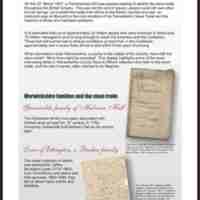
Slavery: A Warwickshire Connection?
An exhibition exploring the connections between Warwickshire and the transatlantic slave trade, using the collections held at Warwickshire Record Office. Several Warwickshire families owned plantations in the Caribbean, such as the Greatheed family of Guy's Cliffe who owned an estate in St Kitts. Vice Admiral Lord Hugh Seymour was prominent in the West Indies as Commander of Britain's naval forces in the Leeward and Windward Islands. Church of England parish registers reveal the presence of black people in Warwickshire's history.
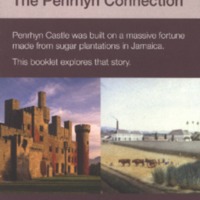
Sugar and Slavery - The Penrhyn Connection
Penrhyn Castle on the outskirts of Bangor in Wales is owned by the National Trust. In 2007, the bicentenary was marked with a special exhibition and accompanying events exploring the connections between the Castle and the fortune of its former owners, the Pennant family, built on Jamaican sugar from one of the largest estates on the island. The exhibition featured the story of Richard Pennant, 1st Lord Penrhyn, a wealthy merchant and MP for Liverpool who fought against abolition in Parliament. Some of the research was carried out by members of the local community, who were trained in archival research by exploring the Penrhyn Jamaica papers held at Bangor University, which included Richard Pennant's letters as absentee landowner.
The project created links between a local school near the Castle, Banks Road school in Liverpool and Mavisville school in Kingston, Jamaica. All three schools provided art, prose and poetry to the exhibition. Workshops were held for all visiting schools. Accompanying events included art days where a local artist worked with visitors to explore the meaning of landscape painting in the context of slavery; a Caribbean weekend; and a day of activities and workshops with a multi-faith groups of teenagers from Liverpool. A DVD of all the information gathered was given free to schools and libraries.
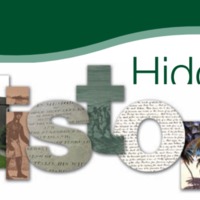
Hidden History of the Dales
This project was a collaboration between the Dales Countryside Museum in Hawes and North Yorkshire Record Office to research people and places of the Yorkshire Dales connected with Africa, the Caribbean and India. 'Hidden History' collected local stories of slave owners and traders, abolitionists, Africans and Asians who moved to the Dales, and others like the actor Ira Aldridge who passed through. The project included various community activities. Working with actor Joe Williams, pupils from the Wensleydale School explored the life of Olaudah Equiano and performed alongside Joe at the exhibition opening. There were drop-in sessions on exploring family history, carnival costume making, talks and music. The exhibition toured to other locations in Yorkshire, including Boroughbridge Library. The Dales Countryside Museum has continued to collect information relating to individuals who were connected with the Yorkshire Dales and the wider world.
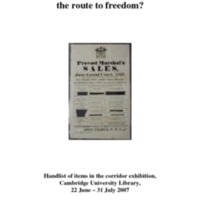
Slavery, shackles and sugar: the route to freedom?
Cambridge University Library held a small exhibition in 2007 showcasing its collections of rare books and manuscripts relating to slavery and abolition. These include records of the Greg family, who owned a sugar plantation in Dominica, and documents relating to slave compensation for the West India colonies. Other records held by the library relate to British Quakers, the abolition campaign, and the persistence of slavery in the 20th century and into the present day.
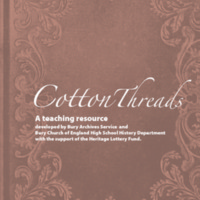
Cotton Threads
Bury Archives and Museum collaborated on an exhibition based on the journals, letters and other papers of John Hutchinson. The Hutchinson family's cotton spinning business had links to slavery in the United States: in 1848, John Hutchinson travelled to America to buy cotton produced by slaves. The exhibition at Bury Art Gallery featured archives, museum objects and paintings that put the papers into a social context. Cotton Threads went on tour to branch libraries, where talks and family workshops explored family histories and the cotton business. Volunteers assisted in conserving, cataloguing and digitising the Hutchinson papers, which were made available online. Primary school pupils took part in workshops held in the exhibition and a resource pack for secondary schools was produced with local teachers (available to download from the Cotton Threads website).
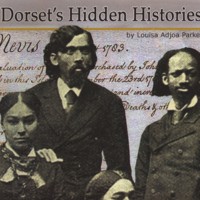
Dorset's Hidden Histories
DEED (Development Education in Dorset) works within the community to develop understanding of global education and cultural diversity. The charity produced and made available to hire the Dorset's Hidden Histories touring exhibition, which explored 400 years of the stories of people with African and Caribbean heritage across Dorset, Bournemouth and Poole. Many Dorset families were involved in slavery, either owning or trading in African slaves, and Black people were brought to Dorset by slave traders to live as servants in the large country houses. The exhibition, which is still available to borrow, also includes details of African American GIs on Poole Quay, a freed enslaved American living in Bournemouth, and Belle Davis, the African-American singer and dancer who performed in Weymouth in 1917. The organisation worked with Louisa Adjoa Parker, a local poet and black history researcher, to provide creative writing workshops to explore the exhibition. An accompanying booklet, written by Parker, can be purchased from DEED.
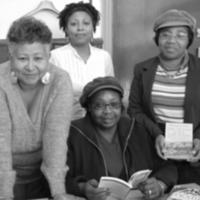
Interwoven Freedom
SCAWDI are a Birmingham-based community group specialising in working with local volunteers to research the early presence of Black people in the West Midlands. In collaboration with English Heritage, ‘Interwoven Freedom’ enabled a group of local women to visit archives, exhibitions and historic sites and explore the role of women in the abolitionist movement. The participants drew on traditions of abolitionist women such as Elizabeth Cadbury creating and distributing workbags filled with anti-slavery manifestos by making their own textile bags from fair trade cotton and African cloth. They wrote their own manifestos which mixed historical facts with fictional stories and poems. The accompanying exhibition of textiles, text panels and an audio documentary toured London and 11 regional venues. The exhibition included photographs documenting the project by photographer Vanley Burke.
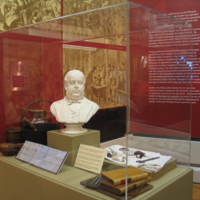
Revealing Histories: Remembering Slavery (Touchstones Rochdale)
Touchstones Rochdale was one of eight heritage bodies in the ‘Revealing Histories: Remembering Slavery’ partnership in Greater Manchester. The project set out to explore the history, impact and legacy of slavery on Britain through collections and community links in the North West.
Rochdale's connections to slavery were explored though two exhibitions at Touchstones Rochdale, which featured museum trails and family events. 'The Fight to End Slavery: A Local Story' examined the town's role in the struggle to end slavery in North America, including the work of prominent abolitionists from Lancashire. The exhibition also looked at the impact of the Lancashire cotton famine, which occurred as a result of the blockade of southern American ports during the Civil War. 'Linking Threads: Textile Industrialists and the Art Collection' focused on works given to the Rochdale Art Gallery collection by benefactors who had links to the local textile industry, such as Robert Taylor Heape and Richard Heape.
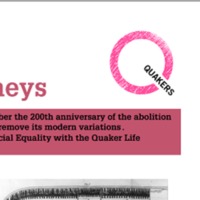
Quakers and the path to abolition in Britain and the colonies
The Society of Friends expressed its formal opposition to the slave trade in 1727, and from that date were vocal opponents of transatlantic slavery. A virtual exhibition of archived resources, ‘Quakers and the path to abolition in Britain and the colonies’, was launched online to commemorate the bicentenary. It traced the history of the anti-slavery movement from its Quaker beginnings and highlighted key events in the Quaker history of opposition to the slave trade, and was primarily based on material from the Library at Friends House. The exhibition also explained the important role played by Quaker women abolitionists through writing and poetry. The Quakers pioneered contemporary tactics such as boycotting, petitions, leafleting and poster campaigns.
Other resources to help people find out more about the bicentenary included ‘Abolition Journeys’, developed by Quaker Life Committee for Racial Equality with the Quaker Life Children and Young People’s Staff Team, designed to help people of all ages remember the slave trade and work to abolish its modern variations.
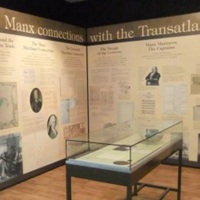
'A Necessary Evil'
An exhibition which explored the connections between the Isle of Man and the transatlantic slave trade between 1718 and 1807, as shown in assorted archives. Mounted in the Lower Folklife Gallery at the Manx Museum, the display revealed evidence of Manx captains, officers and crew recorded on slaving ships in the Port of Liverpool muster rolls or in probate records. Documentation shows Manx merchants dealing in ‘Guinea goods’ and investing in trading voyages; also Manx people part-owning or managing plantations in the Americas. The title quote was taken from the memoirs of Manxman Captain Hugh Crow, published posthumously in 1830. Crow wrote, ‘I have viewed the abstraction of slaves from Africa to our colonies as a necessary evil, under existing circumstances’. In July 1807 the last legal slave voyage for an English vessel began from Liverpool. Crow, aboard 'Kitty’s Amelia', took command en route to Bonny.